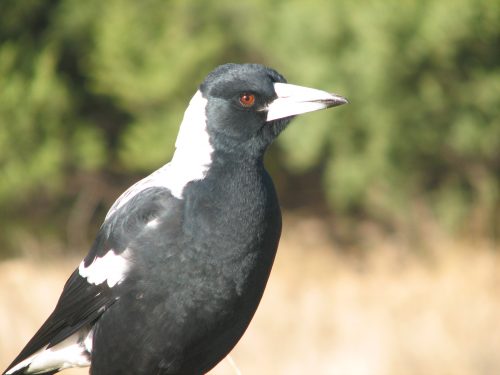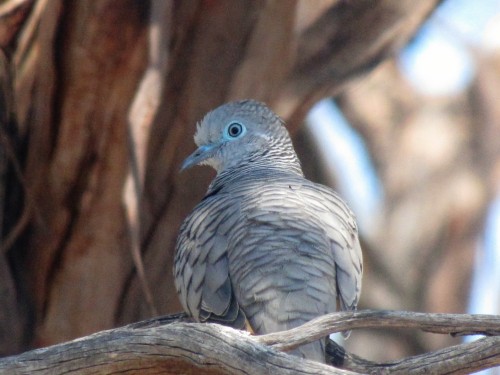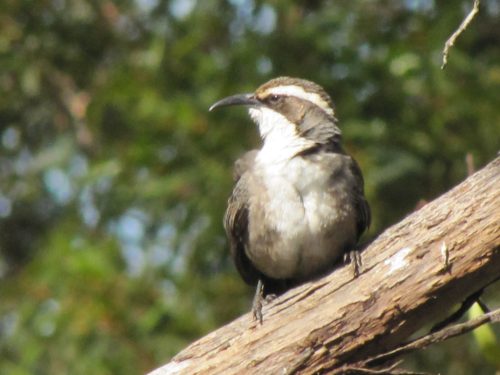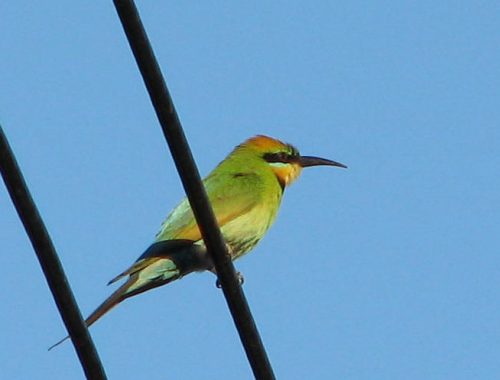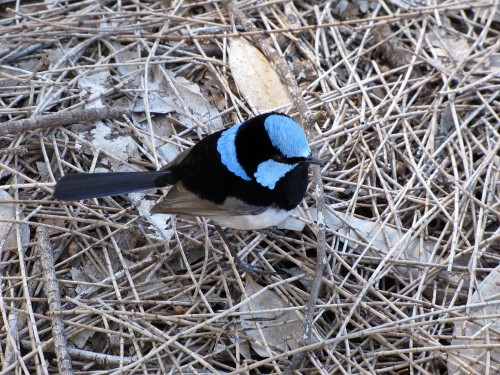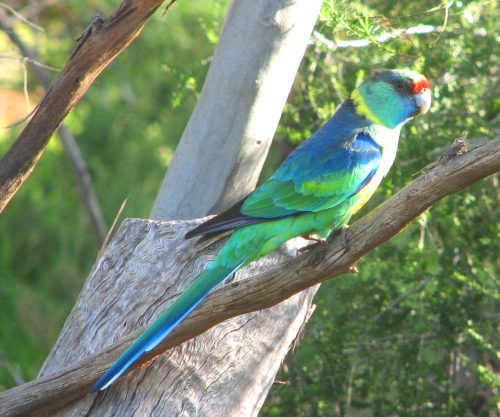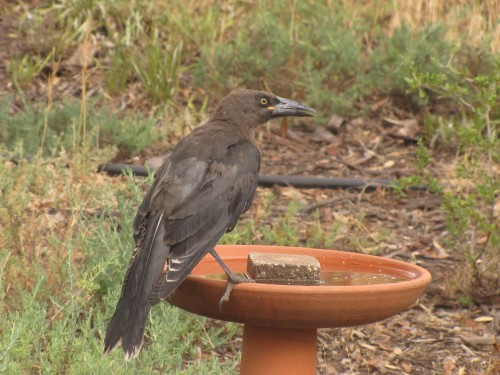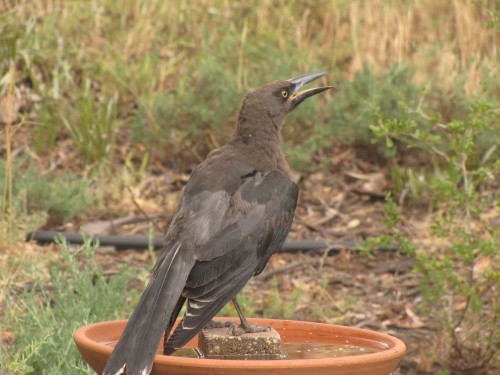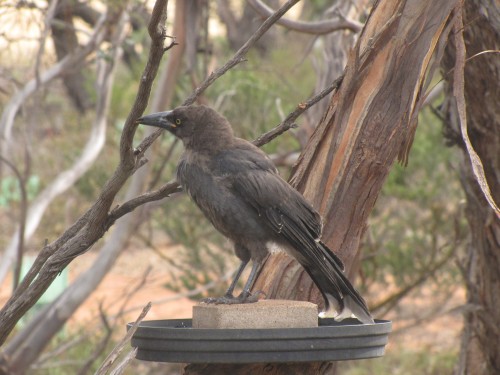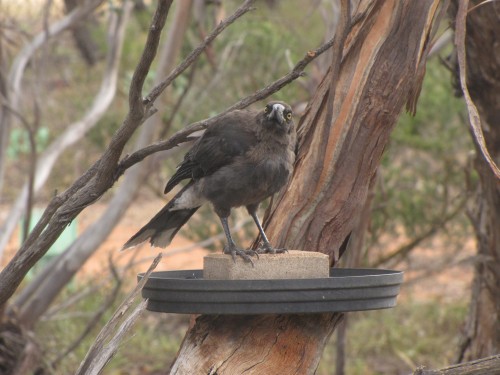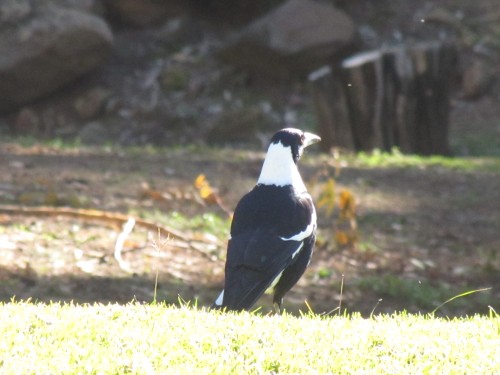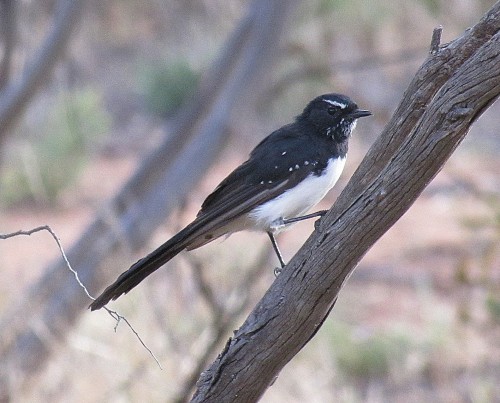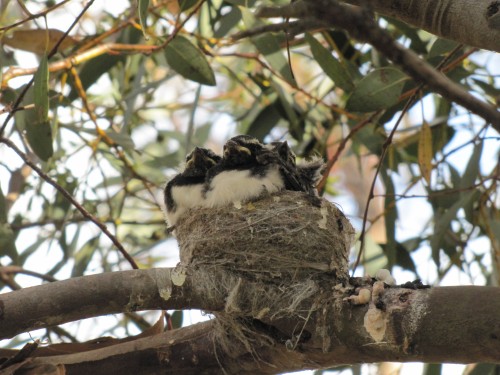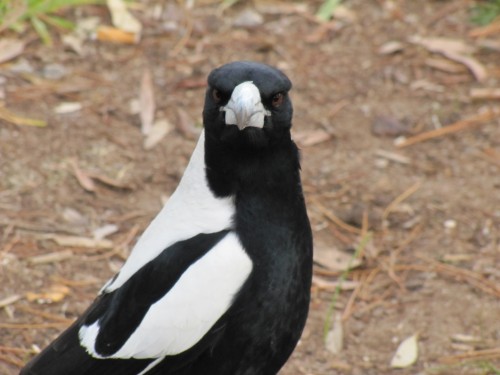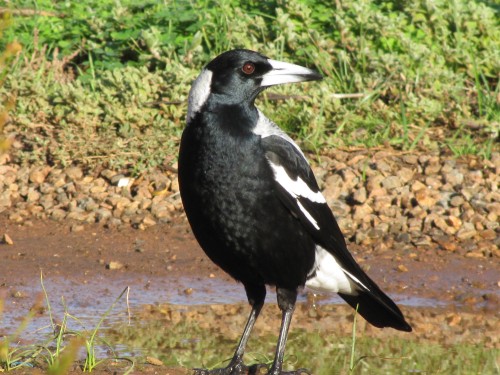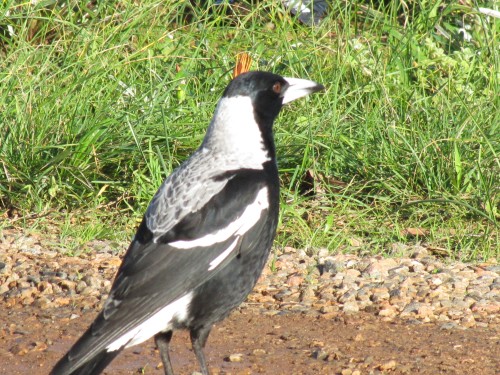Bird visitors at my window
Over recent days we have had both hot weather and lovely weather. This is normal for mid-summer days here in South Australia. For any new readers, I live about 80km or an hour’s drive south-east of Adelaide. Summer temperatures are usually in the high 20s or low 30s (30C is equal to 86F). During our worst summer days, temperatures can soar as high as 45C (113F), but thankfully such days only occur a few times every year.
Over recent weeks, many days have been in the mid-20s, which is very pleasant. On such days I love to open the large window next to my writing desk and let the fresh air into my office. If there is a breeze as well, that is an added bonus. One of the side benefits of this arrangement is the easy access to the bird life in our garden. I don’t even have to get up out of my chair to watch the birds. They come to me.
One one occasion, a friendly Australian Magpie (see photo above) sat on the rail of the pergola on this side of the house. He was in full view from where I sat. He suddenly stopped his carolling – our magpies are wonderful songsters – realised I was there and leant forward to get a better view of me. When I chatted with him, thanking him for the visit and the song, he answered me. How lovely.
On several occasions over the last week, one or two Peaceful Doves have alighted in the branches of a nearby tree, coo-ing persistently for about ten or fifteen minutes before moving on elsewhere in our garden. Their soft calls are very peaceful, so they are aptly named.
Only yesterday I had to stop what I was writing and look out to the garden bed next to my office window. A small family of White-browed Babblers were playing around in the bushes there, scolding each other as they scurried here and there. They were joined in this game by several New Holland Honeyeaters, their screeches usually a warning sign that a hawk or eagle is about. I think they were just having fun with the babblers. Even a couple of House Sparrows joined in the fun.
One species we don’t always have around is the Rainbow Bee-eaters, a delightfully named bird with their many-coloured plumage and their liking for catching and eating bees and other flying insects. I smile when I see one sitting in a nearby tree, banging a bee against the branch to dispatch the sting of the bee before swallowing it whole. Yesterday two or three could be heard out of my window while I worked, and later I saw two gliding overhead. Delightful birds, and we miss them when they fly north for the winter.
For many years we never had wrens resident in our garden. They were only occasional visitors from up the hill. Then five years ago on our return from an overseas trip, we were greeted by two Superb Fairy-wrens, one of two local species. They have been a resident breeding species in our garden ever since, producing several broods over those five years. They are so secretive about their nests that I have yet to find one. They have plenty of good bushes around to build their nests. From time to time they will also come by my office, their twittering, tinkling calls easy on the ears as they hop along near my office window, jumping up occasionally to snatch a fly or mosquito silly enough to hang around too long.
I don’t need to have the window open to hear our resident Mallee Ringneck parrots screeching outside as they fly from tree to tree, or over the house, or just sitting in a nearby tree wagging their tails joyfully. This tail wagging is probably a mating display. They have raised several broods successfully in recent years, their nest hollow being only 30 metres from my window.
What birds do you have in your garden?
Please tell me in the comments.
Good birding,
Trevor
Hot weather birding
Over recent posts I have written about the very hot conditions we have had here in South Australia this summer. I won’t bore you by stating the obvious yet again. When the weather gets much over 30C (86F) I tend not to go out birding, though I have on occasions been out in much hotter weather.
When the temperature soars here in Murray Bridge (80 km SE of Adelaide) I tend to stay indoors as much as possible. It is one of the joys of being ‘retired’. On these occasions we have the delight of a constant stream of birds coming to our bird baths. These containers are strategically placed in our garden where we can observe – and photograph – the birds at our leisure. On very hot days like we have had over recent months the stream has sometimes been a flood.
When the Grey Currawongs come to drink, most of the smaller birds keep their distance. I am not surprised by this; the Currawong’s bill and head is about the size of birds like the thornbills or the wrens. I guess that the smaller species know instinctively that the Currawong is capable of raiding their nests for eggs and baby birds, and so they remain at a respectful distance while the bigger birds are drinking.
During one of our recent hot spells this juvenile Grey Currawong came for a drink. I can tell that it is a young one not long out of the nest because of the downy feathers, as well as the yellow gap on the bill. Only a few days before these photos were taken I saw the juveniles being fed by the adults.
Once the Currawong had finished drinking, the smaller birds quickly returned.
Black-backed Magpie at Dubbo Zoo
I am constantly intrigued by the huge variations in the plumage of Australian Magpies. As we travel from home in Murray Bridge, South Australia, I am always on the alert for all birds seen, and especially for the common magpie.
Here at home we have the White-backed race. As we travel eastwards towards Sydney – to visit family there – we encounter both White-backed and Black-backed as well as many hybrid variations. A few years ago we travelled from Sydney south along the coast, ending up at the home of friends north of Melbourne. Once again I observed many variations in plumage colours.
The photo above was taken as we drove through the Western Plains Zoo in Dubbo, New South Wales on a visit to the zoo last year. All of the magpies I observed in that region were of the Black-backed race, as are those I have seen in the Sydney area. If you have a field guide to Australian birds it may include a map showing the locations of various forms of this species (or at least a description of where they are found).
This should alert people interested in birds – even if it is just a passing interest – to closely observe even the common species. You never know what will come into your field of view.
Good birding.
A feisty Willie Wagtail
One of the most recognisable Australian birds would be the Willie Wagtail (see photo above). It is also one our most endearing birds, a favourite of many people. It loves occupying spaces close to human habitation, especially our gardens. We have a resident pair in our garden and we see them on a daily basis.
I have always known that Willie Wagtails can also be aggressive, feisty little birds. This has been in evidence in recent days in our garden, illustrated by the following incidents when it has attacked other, much larger species:
- Australian Magpies: our resident Magpies must be nesting somewhere on our five acre property here in South Australia. The male is consistently chasing almost every bird which comes near. Fortunately us humans are never swooped. Last Saturday, however, the roles were reversed. It was the magpie being chased – by a very aggressive and angry Willie Wagtail snapping at its tail as it tried to escape its wrath.
- Little Ravens: We often have small flocks of Little Ravens in our garden, usually up to about six or so. Yesterday I heard and then saw three ravens in the large mallee trees at the back of our home. As usual, they were cawing loudly. This attracted the attention of the Willie wagtail who rapidly came into the situation and began snapping at a raven’s feathers, tail and head, harassing the poor bird mercilessly. As soon as one raven flew off with a few caws in protest, the Willie Wagtail would turn its attention to another until all three were well and truly seen off the property.
Wedge-tailed Eagles
I have only observed Australia’s largest bird of prey, the Wedge-tailed Eagle, on one occasion here in over 30 years. It is, however, quite a common bird throughout this part of the country and I have seen the species on many occasions in my travels. It always amazes when the tiny Willie Wagtail – not much bigger than a humble House Sparrow – aggressively attacking the eagle, snapping at it and even pecking at its back while hitching a ride. Such courage – one snap of the eagle’s beak would dismiss the wagtail permanently.
The reason for this aggressive attitude:
Normally the Willie Wagtails are friendly, docile birds. They will allow all manner of birds to cohabit happily in our garden. The reason for this sudden change of attitude is a simple little nest, like the one shown below. The photo below was taken a few years ago because I don’t want to disturb the mother Willie wagtail. She is currently sitting on two lovely eggs. She is not even afraid to come after me when I get near to the nest, snapping near my head until I move a reasonable distance from the nest.
The weeds near the nest will just have to wait a few weeks to be mown. Sigh.
I recently wrote about other birds nesting in our garden (click here).
The problem of swooping magpies
It’s magpie swooping time again.
At this time of year people in many places around Australia are ducking for cover. It is magpie swooping time again. Around July and onwards our Australian Magpies start building or refurbishing their nests ready for the breeding season. Once the female has laid to eggs she is the only one to hatch them. Meanwhile, the male keeps guard over his territory.
Territorial
This species is highly territorial and disputes over their patch are hotly contested. On our five acre (2 hectare) property we have three intersecting territories, so the conflict can sometimes get quite boisterous. Once nesting commences, these bird wars calm down. You could say that they are real life “angry birds”.
Attacks
The fighting doesn’t always end there, however. While the female is sitting on the eggs, or the young are being fed while still in the nest, the male can be very aggressive in guarding his territory against anything, or anyone, he sees as a threat to the success of his progeny. Animals – including dogs, cats, foxes – other birds, walkers, gardeners, joggers and anyone misguided enough to venture within a hundred metres or so of the nest are all fair targets. Cyclists are a particular object of attack.
Damage
The male magpie will usually wait until the target has passed by, and will then attack from behind, a swift, smooth, nearly silent swoop aimed at the head. A swoosh of the wings and a few snaps of the beak from less than a metre behind is often the only warning one gets. By then it is too late. If contact is made the result can be both frightening and bloody. Their sharp beak can inflict a nasty break in the skin, and in a worst case scenario they have been known to damage an eye.
Preventing being swooped
So – what can one do to prevent getting swooped? I recently read this great list which was published here in South Australia in Weekend Plus: a digital magazine for seniors.
“We do need to take care around them because they have sharp beaks and claws and if they make contact, they can draw blood.
“The good news is that swooping season only lasts about six weeks, beginning when the eggs hatch and finishing when the young birds leave the nest.
“The best way to avoid being swooped is to change your route if possible, as they’ll only swoop within 50m of their nests.”
More tips for surviving the spring swoop
- Avoid making eye contact with magpies.
- Walk, don’t run past their nests.
- Travel in groups where possible as swooping birds generally target individuals.
- Carry an open umbrella or wear sunglasses and a broad-brimmed hat.
- If you’re riding a bike, walk your bike through magpie territory or attach a flag to the back that is taller than your head.
- Don’t wave your arms or shout – this just proves you are a threat to the nest.
- If you know of a swooping magpie, put up a sign to warn others.
Further reading:
- Do Blackbirds swoop? How to deal with aggressive birds.
- A bit on the nose – a humorous close encounter with a bird
- Magpies behaving badly
- Bird wars
- Aggressive bird behaviour in the garden
